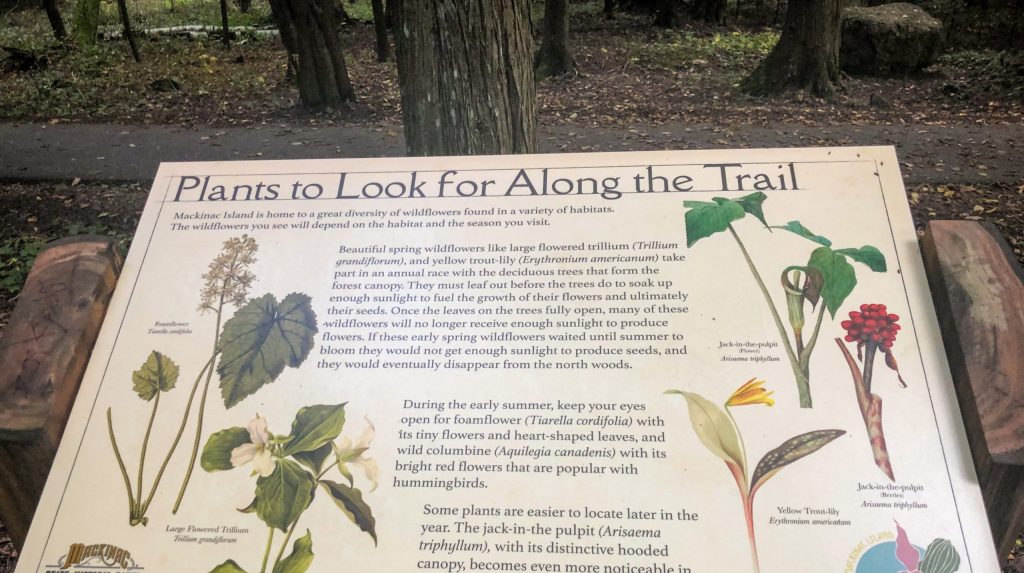Mackinac Island is less than four square miles, yet it offers more than 70 miles of trails. Good for hiking, biking and even horseback riding, the trails crisscross Mackinac Island running along bluffs, over hills, and through the thick canopy of the forest.
While you’re out exploring you might hear the sounds of the birds, smell the sweet scent of a balsam fir tree, or spot a vibrant flower amongst the earthy forest floor and want to know more. The Mackinac Island Botanical Trail is just what you’ve been looking for.
WHAT IS THE MACKINAC ISLAND BOTANICAL TRAIL?
Located along Arch Rock Bicycle Trail, the Mackinac Island Botanical Trail is a product of the Mackinac State Historic Parks and features seven turn-outs with benches and informational signs. With over 600 species of plants identified on Mackinac Island, the Trail provides insight into the early explorers of Mackinac Island, what types of plant life you might see along the way, and the wildlife of Mackinac Island.
- TREES, FUNGI, FLOWERS, FERNS, AND PLANTS ON MACKINAC ISLAND – When you begin the journey along the Botanical Trail, you’ll find signs for trees, plants, fungi, flowers, and ferns you might find on Mackinac Island. Some examples include Cedar Trees, Wall Hawkweed, Norway Maple, Dwarf Lake Iris, Twinflower, Large-flowered Trillium, Foamflower, Jack-in-the-pulpit, Yellow Trout-lily, White Baneberry, Wild Columbine, Eastern White Pine, Yellow Lady’s Slipper, Paper Birch, Marginal Wood Fern, Ostrich Fern, False Solomon’s Seal, Turkey Tail, Fly Amanita, and Tent Stakes. Check out this blog post for a more detailed look at wildflowers on Mackinac Island.
- WILDLIFE AND BIRDS ON MACKINAC ISLAND – Mackinac Island is home to diverse wildlife that thrives in the abundant forest. Along the trail, you’ll get a chance to read about what you might encounter and there is also a tool that lets you listen to the different bird sounds you might hear. The Eastern Chipmunk, Monarch butterfly, Ruby-Throated Hummingbird, Downy and Hairy Woodpecker, Pileated Woodpecker, Barred Owl, Black Squirrel, Fox, and even Deer can be seen on Mackinac Island. Check out this blog post for a more detailed look at birding on Mackinac Island.
- EARLY NATURALISTS OF MACKINAC ISLAND – Many people, both visitors and locals, have been enthralled by the natural beauty of Mackinac Island. Even philosopher and environmentalist Henry David Thoreau visited Mackinac Island and included notes in his journal about his findings. The Botanical Trail includes information on more early explorers and their observations. Check out this blog post about Mackinac Island fun facts including Henry David Thoreau’s documentation of lilacs.
Print this page and go on a Mackinac Island Botanical Trail scavenger hunt!
MACKINAC ISLAND STATE PARK ETIQUETTE
As you’re enjoying the beautiful sights and sounds of Mackinac Island’s Botanical Trail and other areas of the state park, please remember a few things:
- Do Not Pick The Flowers in Mackinac Island State Park – There is a fine for picking flowers in the state park. As beautiful as they are, please leave them where they are.
- Do Not Climb Natural Features in Mackinac Island State Park – Many natural features on Mackinac Island are delicate and subject to erosion, making them dangerous to climb on. They are also sacred places for the Anishnaabek people, so please do not climb rocks or limestone features.
- Stay On Designated Trails – Going off the trail can cause erosion and kills plants and vegetation. Please stay on designated trails. If you need a map, they are located at the Mackinac Island Tourism Bureau Booth or various downtown establishments.
- Leave No Trace – Pick up after yourself and leave no trace. Garbage cans are located throughout Mackinac Island and at various points of interest. Do your part and help us keep Mackinac Island beautiful!
RELATED MACKINAC ISLAND BLOGS:






